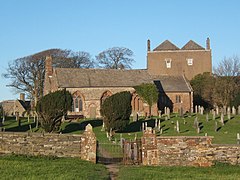| Millom | |
|---|---|
| Town and parish | |
 Millom Castle and Holy Trinity Church | |
Location within Cumbria | |
| Population | 7,240 (2021) |
| OS grid reference | SD172802 |
| Civil parish |
|
| Unitary authority | |
| Ceremonial county | |
| Region | |
| Country | England |
| Sovereign state | United Kingdom |
| Post town | MILLOM |
| Postcode district | LA18 |
| Dialling code | 01229 |
| Police | Cumbria |
| Fire | Cumbria |
| Ambulance | North West |
| UK Parliament | |
Millom is a town and civil parish on the north shore of the estuary of the River Duddon in southernmost Cumberland, Cumbria, England. It is situated just outside the Lake District National Park, about six miles (ten kilometres) north of Barrow-in-Furness (23 mi or 37 km by road) and 26 mi (42 km) south of Whitehaven.
 The older of two lighthouses at Hodbarrow | |
 | |
| Location | Millom, United Kingdom |
|---|---|
| Coordinates | 54°11′39″N 3°15′30″W / 54.1941°N 3.25831°W |
| Tower | |
| Constructed | 1866 |
| Construction | stone |
| Height | 18 m (59 ft) |
| Shape | cylindrical tower with balcony and embattled top, light from a window |
| Markings | unpainted |
| Operator | Haverigg Lighthouse Club |
| Heritage | scheduled monument |
| Light | |
| Deactivated | 1905 |
| Hodbarrow Haverigg Lighthouse | |
 | |
| Constructed | 1905 |
| Construction | cast iron (tower) |
| Height | 9 m (30 ft) |
| Shape | cylindrical tower with balcony and lantern[1] |
| Markings | white (tower), white (lantern), red (horizontal stripe) |
| Operator | Hodbarrow Mining Company (–1946), Hodbarrow RSPB reserve |
| Deactivated | 1949 |
| Focal height | 12 m (39 ft) |
| Characteristic | Fl W 4s |
Millom was constructed as a new town, beginning in 1866 and subsumed the village of Holborn Hill. Built around ironworks, the town grew to a size of over 10,000 people by the 1960s, but has struggled since the works were closed in 1968. Culturally, Millom is notable as the birthplace of poet Norman Nicholson, and for its historical links with rugby league.
The name is Cumbrian dialect for "At the mills".[2]
- ^ Rowlett, Russ. "Lighthouses of Northwest England". The Lighthouse Directory. University of North Carolina at Chapel Hill. Retrieved 2 May 2016.
- ^ Reader's Digest Atlas of the British Isles, place name index.

